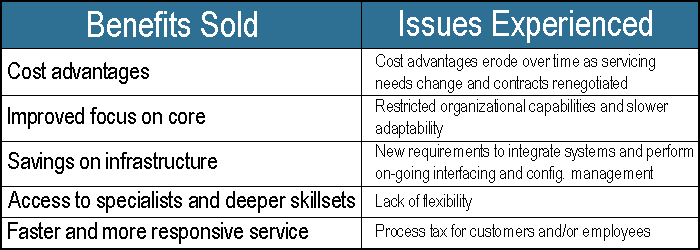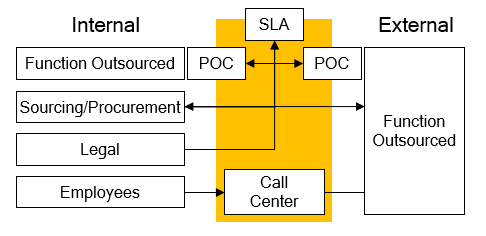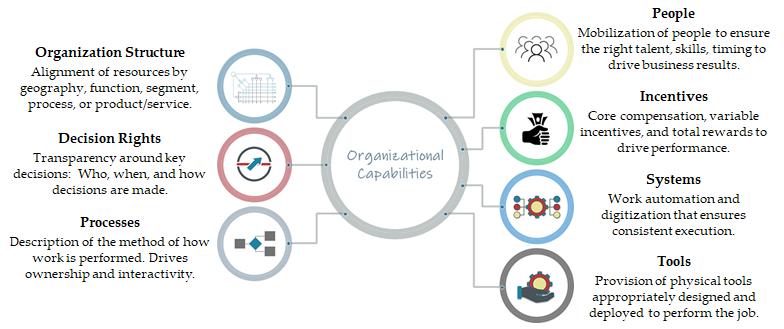by Dr. Dale J. Albrecht
© 2022, Alonos® Corporation
Executive Summary
This white paper examines the organizational design and ecosystem implications of outsourcing. A model for examining business impact is describes, and a template for assessing benefits, and risks is provided. Organizational implications are explored and described. Implications associated with the other six disciplines are also explored, and these include decision rights, processes, systems, tools, people, and incentives.
Elusive Promises
Likely that most people reading this white paper have experienced both sides of outsourcing. Outsourcing has its positives and negatives. It is common to walk away from an outsourcing initiative after a few years and be left wondering: where were the effectiveness and efficiency gains? Over the past few decades, there are common experiences that have developed around outsourcing.

In order to improve the ability to realize the benefits and to simultaneously reduce the risks of experiencing the issues, there are a core set of items that need to be put in place. Those include organizational structure, decision rights, processes, systems, and people.
Effect on the Business Ecosystem
From a business standpoint the premise of outsourcing is straightforward. Outsourcing is pursued when the business believes that it can obtain products and/or services more effectively and efficiently through an external transaction versus doing it themselves internally. Much like any other change that a company might make to its organization, an outsourcing strategy will have an effect on its business. To understand the impact, start with diagraming the changes to organizational capabilities. Outsourcing any function effects organizational capabilities. The question is: How?
Useful Template
To understand what’s going to change, use a template like the one shown below. Be realistic, not everything is going to be retained or improved. Be sure to identify what’s at risk. Below is a lite example for payroll; the scan template can be used for any business capability/function.

Organizational Implications
The value chain function being outsourced will drive the organizational implications. Direct value chain functions will have a more direct impact on business performance, and they will receive a larger-degree of focus and attention. For example, outsourcing marketing has a more dramatic impact on business performance than outsourcing payroll might. Marketing directly impacts customer traffic; whereas, payroll affects employees, who then affect business performance. The marketing function has a direct impact where payroll has an indirect impact.

All functions outsourced have new implications to organizational structure. The figure shown here illustrates some of the commonly experienced needs. The function being outsourced inevitably ends up having a point-of-contact (POC) role in both organizations. These individuals/teams are responsible for managing the relationship and working with each other on a day-to-day basis. The work that is performed is governed by a contract/service level agreement (SLA). Putting in place the SLA requires the active involvement of legal support; additionally, there are on-going needs for legal support as the business situations change. Depending on the type of function being outsourced, there may be a call center that’s used. Depicted above is a situation where it’s an employee call center (e.g. payroll outsourcing,) but it can also be a call center that addresses customers. A customer call center would be in-scope if outsourcing included aftermarket support. Irrespective of the function being outsourced, the organizational implications shown above will need to be addressed.
Other Implications
There are seven disciplines that work together affecting business performance. Organizational design/structure is one of the seven. When considering outsourcing, all seven disciplines should be examined for implications. Along with the organizational implications highlighted in the previous section, there are other implications in almost every other discipline.
Decision Rights should focus on key decisions that will impact the performance of the outsourced production and/or servicing. These will be decisions that address capital and operational expenditures, along with the allocation of people resources. It is important to identify the decisions and the deciders up-front. Often, the level of decision will have different deciders, with levels that require SLA and contract negotiations being retained at a higher level in the organization. Clarity is essential to ensuring proper operation of the relationship. (Learn more about effective decision making.)
Process Design will need to be accomplished in at least two major areas. The first, which is the most obvious to people, is how the production and/or services will be performed. Almost all process-level attention is given to this area. The second, which is equally important, is the management cadence that will govern the relationship. The process for business reviews, SLA reviews, key performance indicators (KPIs,) and escalation/response mechanisms should be defined prior to going live with an outsourcer.
Systems considerations in outsourcing tend to go hand-in-hand with process work around production and service. Any point where there is a system that needs to be shared, integrated, or interfaced will need to be planned and designed. In addition, each of the interfaces should receive both a plan and funding for regular review and updating. When either party goes through systems changes, it will potentially impact the other. Interface configurations become an ongoing need.
Tools is probably the one discipline that is most often overlooked, at least explicitly and formally. In an outsourcing situation, the tools that are most commonly needed are those that enable the day-to-day management. They are the tools that the POCs will utilized to manage performance and relationship. At a minimum the tools should include all software, applications, equipment, reports, and metrics that will be required.
People considerations include the new roles required by the structure. Also in-scope are internal displacements caused by the outsourced arrangement. More important that either of these two people implications are the implications to the rest of the internal employee group. Often overlooked are the training and communications needs of the employees so that they can effectively use and interact with the outsourcer. The new outsourced arrangement is hardly ever seamless, and there are almost always changes in process and workflow. Employees should be made aware so they can engage in the most product manner possible.
Incentives impact is also two-fold, at a minimum. The first incentives consideration is for those who will be managing the outsourced operation in an on-going manner. Should the company provide incentives to ensure that they derive the benefits defined and avoid the risks? (Worthwhile for sure.) The second incentives consideration is regarding the ability of the company to provide and define incentives that will impact their own business performance. If the outsourcer will provide production and/or servicing that impacts the company’s own production and servicing, the company will want to retain some influence and control over these. In the special case of payroll outsourcing, one should be extra cautious because it places additional risk on a company’s ability to define, manage, and pay incentives for their own employees. (View a complimentary infographic on Compensation and Incentives)
Recommended Citation:
Albrecht, D.J. (2018). Designing Organizations: Outsourcing (White Paper). Dallas, TX: Alonos Corporation. Retrieved from: alonos.com/resources
For further reading on this subject, pick up Dr. Albrecht’s book:
You can order it through major booksellers


